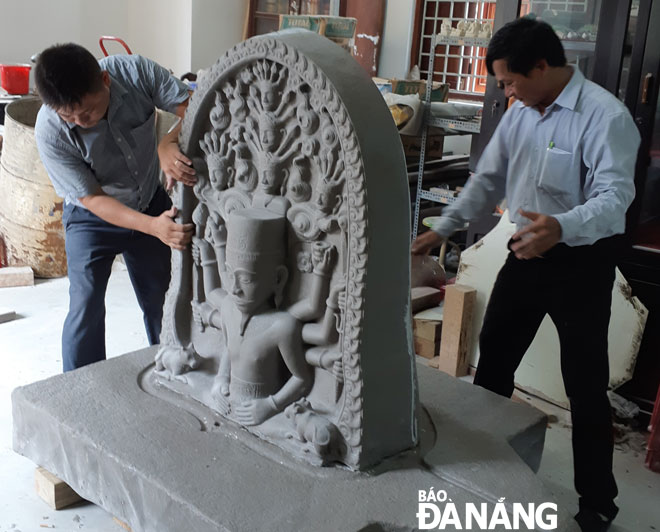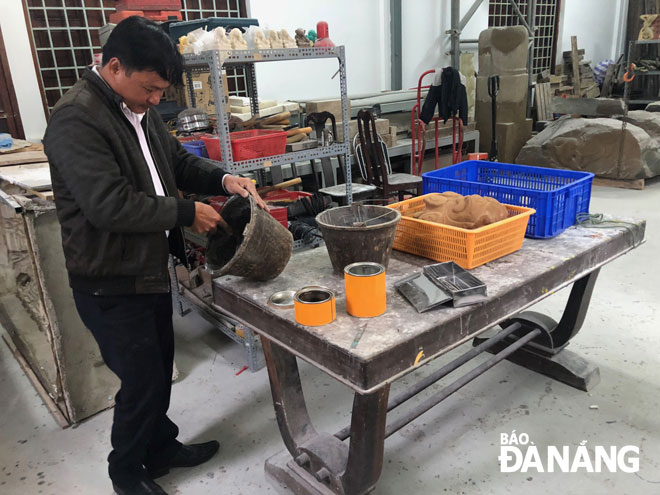Meticulous care for exhibits at Museum of Cham Sculpture
The Museum of Cham Sculpture is thought to have been one of the first 3 museums to be established in Viet Nam, and it has become one of the world's most famous collections of Cham artifacts. The exhibits all showcase the cultural exchanges and development of Asian countries during medieval times, and represent the pinnacle of the Champa civilisation.
 |
| Two experts getting involved in making a version of the Siva statue at the Museum of Cham Sculpture |
The rich collection of Cham artifacts has been attributed to the great efforts of the museum’s staff over the historical periods, especially those who are involved in the preservation and restoration of artifacts.
Recently, the museum’s staff have created a version of the Siva statue (King Po Ramé) consisting of 2 parts. In detail, below is 30 cm-high and 130 cm-wide Yoni, an iconic representation of goddess Shakti in Hinduism, whilst the upper section features a large bas-relief carved in the shape of a god with 8 arms, surrounded by 5 heads and many auxiliary decorative motifs. The original exhibit is on display at the Po Rome tower located in Hau Sanh Village, Phuoc Huu Commune, Ninh Phuoc District, Ninh Thuan Province.
In addition, the museum’s staff have created many such valuable versions as Tara Bodhisattva statue, and many types of pedestals.
As for original items which have damaged and broken, renovation is embanked upon them before their display. A Linga artifact, for example, had some chips in the upper part and lost the below altar. It has been found in the Binh Dinh Province-located Dark Tower, and displayed at the museum at the beginning of the 20th century. After the restoration of its lost part, the Linga statute is now considered to be the second largest of its kind, measuring 1.66m in height.
 |
| The restoration of artifacts requires diligence and caution |
In an effort to seek the anti-degradation solution for the museum’s exhibits, in 2001, the city’s museum cooperated with the Western Sydney University in Australia to discuss appropriate preservation methods for stone artifacts.
Thanks to this, experts from the 2 sides have found effective preservation measures, including making dust-proof glass doors, controlling humidity, replacing iron bolts with stainless steel pins, using two part epoxy adhesives for bonding a wide variety of materials, applying Nanotechnology in reinforcing the surface of artifacts with high-quality dedicated glue.
In 2003, the museum continued its cooperative ties with the France-based Guimét Museum to deploy anti-degradation tasks for its entire collection. Accordingly, the French museum provided modern technical equipment for the establishment of a restoration and preservation workshop at the city’s museum, and sent its experts who boast rich experience in restoring stone sculptures to help the Da Nang-based museum.
Since its inception, not only had the workshop conducted good renovation activities, but it also made many highly-appreciated versions of artifacts at the museum.
Currently, the museum’s exhibits are arranged in a geographic order according to the places where they were found. This arrangement helps visitors understand the various styles of Cham architecture, which differs with one another according to local lifestyles and culture.
With 16 years of experience working for the restoration workshop, Mr Do Hoang Dao has participated in training courses taught by leading experts from the Ha Noi-based L’École Française d’Extrême-Orient (EFEO), the France-based Guimét Museum and other institutes.
“Because of the nature of our profession, we always remind ourselves of being very diligent and careful at work. Aside traditional preservation ways, we have accessed the latest preservation and restoration methods. We have always longed to make greater efforts to take care of the museum’s collection so that it can catch much more attention from visitors here”, said Dao.